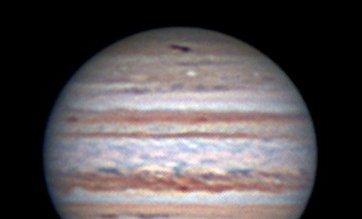| SPLIT SPACESHIPS: Yesterday, space shuttle Endeavour undocked from the International Space Station in preparation for a July 31st return to Earth. The split means there are now two bright spacecraft orbiting Earth. Check the Simple Satellite Tracker for flyby times. JUPITER UPDATE: Something interesting is happening to the dark impact mark on Jupiter. Not only is it growing larger, but also "it seems to be developing two lobes," says amateur astronomer Mike Hood, who sends this July 28th picture from Kathleen, Georgia: 
The same result has been obtained by astrophotographer Raffaello Lena of Rome, Italy. "On July 27th, the Jupiter impact site has evolved and now contained two condensed nucleii," he says. These changes are surely caused by dynamics in Jupiter's upper atmosphere. High-resolution images from the Hubble Space Telescope show that the impact cloud is being molded by high-altitude winds and turbulence. On a planet where vortices are ubiquitous, perhaps it is no surprise that a cloud would organize itself into two or more swirling spots. Amateur astronomers are encouraged to continue their monitoring: sky map. The cloud is located near Jupiter's System II longitude 210°. For the predicted times when it will cross the planet's central meridian, add 2 hours and 6 minutes to Sky and Telescope's predicted transit times for Jupiter's Great Red Spot. SPACE STATION SILHOUETTE: It happened in a split second. On July 26th, the International Space Station (ISS) flew in front of the sun over Orleans, France, where astrophotographer Thierry Legault was waiting. He couldn't see the 0.8s transit with the unaided eye, but his telescope and digital camera captured this image: 
Photo details: Canon 5D MkII, Takahashi TOA-150 refractor, Herschel prism, 1/8000s
"The silhouette shows space shuttle Endeavour docked to the ISS," he says. "The shuttle's payload bay arm is visible, too." Legault has taken many pictures of spaceships passing in front of the sun. When he stands beside the telescope at the moment of transit, listening to the camera click, there is no assurance of a good shot. "I never know if the ship will be visible or not, or if the seeing will give good or bad images. The discovery of the silhouette on the computer screen later is the moment I prefer and is a great pleasure." The ISS will be transiting the French sun again, perhaps several times, in the weeks ahead, says Legault. Stay tuned for snapshots.
July 2009 Aurora Gallery
[previous Julys: 2008, 2007, 2006, 2005, 2004, 2003]
2009 Noctilucent Photo Gallery
[previous years: 2008, 2007, 2006, 2005, 2004, 2003]
July 22nd Eclipse Gallery
[previous eclipses: Jan 26, 2009; Aug. 1, 2008; Mar. 19, 2007]
Explore the Sunspot Cycle | 
